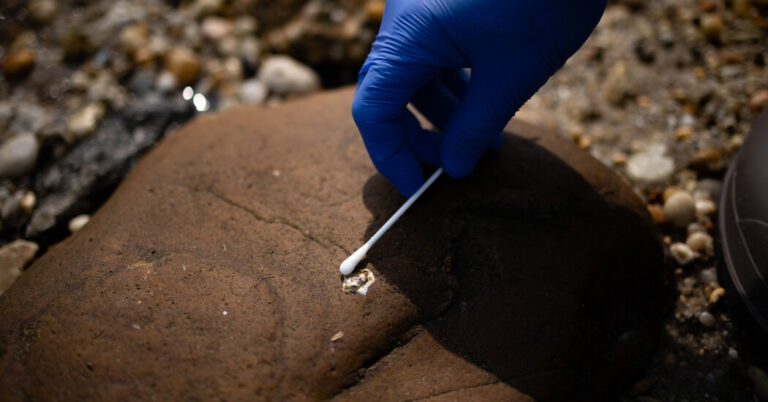
[ad_1]
New Yorkers, beware: If you come across a bird or animal that is sick, dead or behaving strangely, keep yourself and your pets at a safe distance. The bird flu virus, H5N1, is present in at least some small fraction of New York City birds, according to a new study.
The finding is not entirely surprising, given that H5N1 has now been shown to affect migratory birds, a wide range of wild animals, poultry and, as of last month, dairy cows. Still, its discovery in the city is an unpleasant reminder that urban spaces are not exempt.
People generally associate zoonotic diseases with rural settings, farms or the wilderness, said Florian Krammer, a flu expert at the Icahn School of Medicine at Mount Sinai in New York who led the study, which was published online last week.
But New York City has many green spaces and bodies of water used by migratory and local birds, he said: “There is an extensive interface between wild animals and humans in cities.”
“There is no reason to panic, but it’s good to be aware of it,” he added.
Last week, the Centers for Disease Control and Prevention warned health care providers to watch for signs of bird flu infection. So far, only two Americans have been reported as infected with H5N1, one in 2022 and the other earlier this month.
The virus has caused large outbreaks in mink and foxes, and wiped out thousands of marine mammals, especially in South America. Scientists have tracked the virus along migratory routes and stopovers, among wild birds in rural areas and commercial poultry operations and, most recently, among cattle on dairy farms.
But by now, the virus “is everywhere,” said Seema Lakdawala, a virologist at Emory University. “I would be surprised if in any urban environment you went into, you didn’t find some small percentage of H5.”
“This is an important lesson for all big cities,” she added.
Migratory birds and other species live in urban green spaces and wetlands, where they may encounter scavengers, like squirrels, pets and even people. Cats and dogs are susceptible to the bird flu virus and can acquire it from infected birds, their feces or contaminated water.
“People don’t think there’s much wildlife in New York City, but we’re really quite rich,” said Rita McMahon, director and co-founder of the nonprofit Wild Bird Fund, a wildlife rehabilitation center in New York City.
The new study is a product of the New York City Virus Hunters initiative, a collaboration between the rehabilitation center, Mount Sinai scientists, community members and a science outreach organization. It includes high school students who are members of minority groups underrepresented in science.
From January 2022 to November 2023, researchers collected samples from bird species ranging from wild ducks and geese to shorebirds and raptors. Some of the birds were already dead; others showed neurological symptoms and were euthanized.
Among the roughly 1,900 samples from the animals, they found versions of H5N1 in six, in four species: Canada geese in the Bronx and Queens; a red-tailed hawk near a major highway in Queens; a Canada goose and a peregrine falcon in Brooklyn; and a chicken in Upper Manhattan.
The researchers were not surprised to find the virus in Canada geese and raptors, but “it was somewhat unexpected to receive samples from a chicken found in Marcus Garvey Park,” they wrote.
The team has found two more infected birds since the study ended. “My expectation is that as we keep looking, we’ll find more,” Dr. Krammer said. The low number of infected birds found so far may be the result of the test the researchers used, which does not detect small amounts of virus, he said.
Dr. Lakdawala praised the citizen science aspect of the project as way to gather more samples than would be possible only from formal surveillance efforts, while also educating the public on handling samples safely.
“The U.S.D.A. can’t do everything, C.D.C. can’t do everything,” she said, referring to the federal agencies that typically carry out such surveillance. “We really need to have broader networks in place so we can get a better snapshot of what’s happening and what the viruses are.”
At the same time, she said, residents should be responsible and not touch a dead bird. New York City’s health department advises residents to report birds and animals that are sick, dead or acting strangely by calling 311.
Each year, some 9,000 people bring in wounded wildlife — from songbirds and pigeons to squirrels and opossums — to the Wild Bird Fund’s rehab center. Some people are teary. Others “come in kissing a sick goose, thinking it’s going to help it,” Ms. McMahon said.
But now, New Yorkers should be even more cautious when they see an injured or sick bird or animal, she said.
“It doesn’t mean they can’t rescue it and bring it to us,” Ms. McMahon said. But people should wear gloves, wrap the animal and take other precautions.
And “no kissing,” she said. “Direct physical affection is not a plus to the animal.”
[ad_2]